| 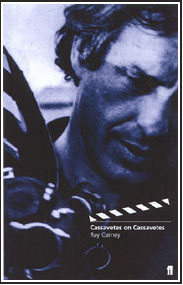 ....Written
immediately after he finished playing the starring role in Paul Mazursky's
Tempest and filmed after he had already begun to be ill, Love
Streams is Cassavetes' Prospero-like farewell to his art. He weaves
dozens of references to his previous work into the movie and waves good-bye
to his audience in the final shot. ....Written
immediately after he finished playing the starring role in Paul Mazursky's
Tempest and filmed after he had already begun to be ill, Love
Streams is Cassavetes' Prospero-like farewell to his art. He weaves
dozens of references to his previous work into the movie and waves good-bye
to his audience in the final shot.
Love Streams asks
the question of how can we keep the possibilities of love alive in
a world
in which love is never less than difficult at best. The film follows
the destiny of a couple at the end of everything – Robert, a
Hollywood hilltop recluse who has decided that "love is a fantasy
for little girls"
and that sex is all that is real; and Sarah who refuses to abandon her
romantic dreams even when her love life comes crashing down around her.
Cassavetes told me that the
sequence in which Robert and Sarah sit in the kitchen late one night and
talk about whether "love is an art" was his favorite scene.
Its beauty is that, like everything else in the film, it takes its
time. The viewer participates in a slow, delicate unfolding in which
a man and a woman briefly come together and then draw apart. Cassavetes'
vision is profoundly temporal in nature. All of life is flowing, streaming,
in motion. Everything is surging, opening, and closing. Nothing stands
still. Not even truth or love. Life takes time to live. Intimacy takes
time to develop. Love takes time to grow. Relationships take time to mature.
Of course, what is made in
time is always in danger of coming apart in time. That is why nothing
is ever final or ultimate or permanent in Cassavetes' work. Everything
is forever in transit, in process, unendingly being born and dying. Even
in this film about endings, Cassavetes shows us that life and love are
always beginning anew....
* * *
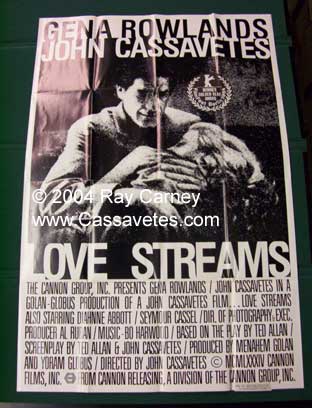 Critics
sometimes talk as if great art gives us new thoughts, when it would
be more accurate to say
it gives us new powers. If Cassavetes' work is about transforming his
characters, it is even more about transforming his viewers. To watch Faces,
A Woman Under the Influence, or Love Streams is to be given
new capacities of sensitivity and awareness – something much greater
and more revolutionary than new ideas. Cassavetes gives us new forms
of perception,
not just new meanings. Critics
sometimes talk as if great art gives us new thoughts, when it would
be more accurate to say
it gives us new powers. If Cassavetes' work is about transforming his
characters, it is even more about transforming his viewers. To watch Faces,
A Woman Under the Influence, or Love Streams is to be given
new capacities of sensitivity and awareness – something much greater
and more revolutionary than new ideas. Cassavetes gives us new forms
of perception,
not just new meanings.
Specifically, he trains us
to watch the faces, bodies, and voices of his characters with unusual
acuity. No filmmaker has done more to make the subtlest nuances of body
language the fundamental building blocks of meaning. Every film might
be said to be acted, but virtually no film is acted to the extent Cassavetes'
are – none relies more heavily on the viewer's ability to read
the tiniest facial flickers of emotion or listen to tonal demisemiquavers
with greater
sensitivity. It is as if the very atoms of the soul were put under a
microscope and made visible as they vibrated in place or darted back
and forth between
characters.
Although Cassavetes' work is
dramatically structured in quite elaborate ways (Faces, for example,
consisting of an intricate network of sexual comparisons and contrasts,
A Woman Under the Influence employing allusions to Rebel Without
a Cause and a series of operatic and balletic visual and acoustic
stylizations, The Killing of a Chinese Bookie drawing on Sternbergian
and Wellesian notions of art, Minnie and Moskowitz tweaking and
teasing Hollywood forms of expression), to a remarkable degree, Cassavetes'
meanings are not created with general stylistic effects or narrative
forms of organization (the way meanings in most other American films are),
but emanate from the faces, bodies, and voices of specific performers.
While, in the other sort of film, we watch how the frame is composed,
how a character is lighted, how the camera moves or doesn't move, etc.,
Cassavetes' work cultivates different ways of seeing and hearing. We are
not looking at the lighting or framing, but attending to butterfly flutters
of feeling in a character's face; we are not listening to the sound design,
but vibrating to birdsong vocal tremulations in a character's voice.
 That
is, in fact, why most serious American film scholars have ignored Cassavetes'
work. The films are treated as if they were merely the record of dramatic
performances imagined somehow to be independent of them as films.
The thinking goes that when we watch a movie like Citizen Kane,
2001, or Apocalypse Now, we feel the director's presence
and choices in more or less every shot, since we are awash in generalized
stylistic effects of lighting, framing, and sound. When we watch Cassavetes,
the argument runs, we are not exposed to the choices of the director but
those of the performers. Ergo, his work is an "actor's cinema"
– in other words, a form of filmmaking not truly "cinematic." That
is, in fact, why most serious American film scholars have ignored Cassavetes'
work. The films are treated as if they were merely the record of dramatic
performances imagined somehow to be independent of them as films.
The thinking goes that when we watch a movie like Citizen Kane,
2001, or Apocalypse Now, we feel the director's presence
and choices in more or less every shot, since we are awash in generalized
stylistic effects of lighting, framing, and sound. When we watch Cassavetes,
the argument runs, we are not exposed to the choices of the director but
those of the performers. Ergo, his work is an "actor's cinema"
– in other words, a form of filmmaking not truly "cinematic."
The way out of the definitional
trap is to realize that the decision to make faces, bodies, and voices
the sources of meaning is as much an expression of the director's values
and vision as the decision to downplay the expressiveness of such things
in the other sort of film. The values are just different. That is to say,
Cassavetes' style is as cinematic as Hitchcock's. It just figures an entirely
different understanding of life and expression.
While the stylistic practices
of conventional cinematic expression (the use of light, sound, camerawork,
framing, and various symbolic and metaphoric forms of presentation) generalize,
abstract, and allegorize experience, the expressive embodiments of Cassavetes'
style physicalize, individualize, and particularize it. Hitchcock's characters
and situations are generic, representative, dreamlike; Cassavetes' are
unique, specific, localized. Hitchcock gives us Everyman doing anything;
Cassavetes gives us someone doing something.
Even more importantly, in the
stylistically inflected film, meaning is tipped toward the visionary.
It expresses more or less disembodied, imaginative states (and is apprehended
by the viewer's identification with and participation in such states of
abstraction and disengagement). Experience is turned into a mental event.
In Cassavetes' work, meaning and experience are practical, engaged, worldly.
Insofar as meaning inheres in the body and is expressed through practical
social interactions (and through the viewer's intricate perceptual negotiation
of those interactions as he or she watches the film), meaning is not in
the mind, but in the world. Cassavetes lowers his figures' centers of
gravity and moves his characters and viewers away from states of unworldly
vision and into practical acts of social negotiation. (Cosmo shows us
Cassavetes' feelings about visionary stances and relations.) Characters
are not their thoughts, feelings, and intentions, but their gestures,
tones of voice, and bodily expressions.
Finally, stylistic effects,
as they occur in the mainstream film, to a large extent, stand still.
If an interaction is kick-lighted one moment it will tend to be kick-lighted
the next; if the music is suspenseful at the start of a scene it will
generally still be suspenseful a minute later. In Cassavetes' work, because
the meanings are a matter of particulars of timing, pacing, body language,
facial expression, and vocal tone, nothing will stop moving or summarize
itself in this way. Meaning is as labile as voice tones and facial expressions.
To watch these films is to inhabit a world of exhilaratingly, scarily,
shifting meanings. There is no predicting the next beat.
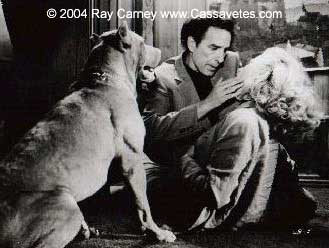 Not
only can Richard and McCarthy or Nick and Mabel tonally be at knife
point one moment and cozy buddies
the next, but even in getting from one point to the other, they can go
through dozens upon dozens of incremental, zig-zagging swerves of
expression.
In Love Streams Sarah and Jack cycle through twenty or more tones
and relations to each other, Judge Dunbar, and Debbie in the hearing
room
in three or four minutes. To watch Robert interact with Albie at the
bar or with the transvestites in the nightclub is to watch meanings
that shift
from second to second. It's an extraordinary place to get a work of art
to – where streams of microscopic energy are flowing, coruscating,
flickering more rapidly than we can keep up with them. There is no
Archimedian stylistic
point outside of the flow by which we can get theoretical leverage on
it. Not
only can Richard and McCarthy or Nick and Mabel tonally be at knife
point one moment and cozy buddies
the next, but even in getting from one point to the other, they can go
through dozens upon dozens of incremental, zig-zagging swerves of
expression.
In Love Streams Sarah and Jack cycle through twenty or more tones
and relations to each other, Judge Dunbar, and Debbie in the hearing
room
in three or four minutes. To watch Robert interact with Albie at the
bar or with the transvestites in the nightclub is to watch meanings
that shift
from second to second. It's an extraordinary place to get a work of art
to – where streams of microscopic energy are flowing, coruscating,
flickering more rapidly than we can keep up with them. There is no
Archimedian stylistic
point outside of the flow by which we can get theoretical leverage on
it.
That's what makes Cassavetes'
films so different from their summaries or the memory of them. In summary,
A Woman Under the Influence might seem like a fairly clichéd depiction
of "a misunderstood, neurotic housewife" (as one early reviewer
put it). In actual experience, it is entirely different. The summary doesn't
even come close to touching the actual experience of what we see and hear.
It is not a film of generalizations, but of startling, unclassifiable,
individualized, unpredictable, astonishing details. Consider just
the first two or three minutes in which we see Mabel: the way she is dressed,
her hopping around on one foot, the way she rides the bike to the car,
the way it won't fit into the trunk, the way the trunk won't close, the
way the car stalls (a detail added in post-production), her shimmering
tones. Nothing is generic, representative, or indicated. Every instant
is new. Every local detail stunningly realized.
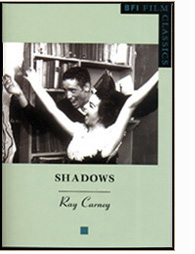 To
cycle back to my beginning, that is ultimately what it means to say that
Cassavetes' works are perceptual more than intellectual events. To put
it more precisely, one might say that they redefine intellect as perception.
Sarah and Mabel aren't a set of ideas about women (the way Thelma
and Louise are); they are a set of specific events. Cassavetes' films
are all details – all the way down to the ground. They tell
us that specifics are, in fact, all there are. To
cycle back to my beginning, that is ultimately what it means to say that
Cassavetes' works are perceptual more than intellectual events. To put
it more precisely, one might say that they redefine intellect as perception.
Sarah and Mabel aren't a set of ideas about women (the way Thelma
and Louise are); they are a set of specific events. Cassavetes' films
are all details – all the way down to the ground. They tell
us that specifics are, in fact, all there are.
The de-ideologization of Cassavetes'
depictions, the semantic embodiment of his expressions, the emphasis on
perceptual events figures a comprehensive vision of all of experience.
T.S. Eliot said of Henry James that he had a mind too fine for an idea
to violate it, and of Cassavetes it might be put more strongly: In his
work ideas are opposed to understanding. Like William James, Cassavetes
saw conceptual relations to experience (including the ones that generalized
stylistic effects create and the ones critics that explicate such films
habitually indulge in) as betraying it, because they abstract us from
and stop the motion of life. While sensory experiences never pause, ideas
stand still. All of Cassavetes' work is an effort to capture the feeling
of unconceptualized experience, to replace conceptions with perceptions.
He tells us we must learn to think without ideas.
One might say that the reason
Cassavetes' films feel so different from mainstream works is that
he is
doing nothing less than swimming against the entire Western intellectual
tradition as it was inflected by Plato – contravening two millennia
of post-Platonic contemplativeness, dephysicalization, disembodiment,
and
spiritualization.
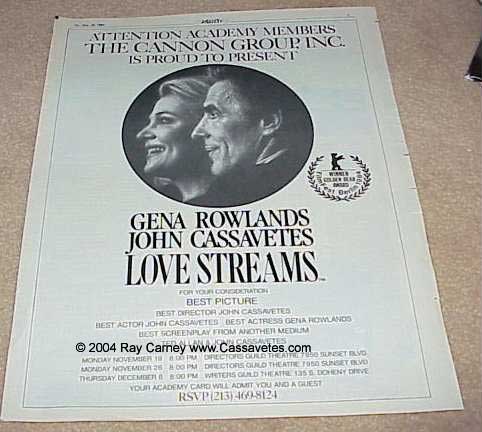 The attack on abstractions
is not only enacted in the viewing experience of the films but dramatized
by the situations of the characters. Figures like Shadows' Lelia,
Faces' Maria, Minnie and Moskowitz's Minnie, and Love
Streams' Sarah are asked to put aside the intellectual burden of their
memories, learn to live in the present, and enter into fresh, nonconceptualized
relations to their own experiences. (Some rise to the challenge, and some
don't in the course of their narratives.) Like the viewers of these films,
the characters in them are asked to learn to flow with the perceptual
flow of life. The attack on abstractions
is not only enacted in the viewing experience of the films but dramatized
by the situations of the characters. Figures like Shadows' Lelia,
Faces' Maria, Minnie and Moskowitz's Minnie, and Love
Streams' Sarah are asked to put aside the intellectual burden of their
memories, learn to live in the present, and enter into fresh, nonconceptualized
relations to their own experiences. (Some rise to the challenge, and some
don't in the course of their narratives.) Like the viewers of these films,
the characters in them are asked to learn to flow with the perceptual
flow of life.
Figures like Robert in Love
Streams (or Richard, Zelmo, and Cosmo in earlier works) are judged
negatively precisely because of their inability to open themselves to
the flux of experience in this way. Robert is a Beverly Hills Thoreauvian.
Like a big budget re-incarnation of Cosmo Vitelli, he has built himself
an imaginative tree-house and pulled up the ladder. He lives the Coleridgean
dream of creating a Xanadu within which the self can imaginatively wall
out disturbance. (I was told, not by Cassavetes, that Robert's character
may have been loosely based on the life of Leonard Bernstein or someone
else the filmmaker knew.)
Robert's goal is to play all
of the parts in a one-man show of his own scripting, directing, and
producing. As exemplified by the scene in which he "interviews"
Joannie or makes a "research trip" to a gay bar, Robert declines
to participate in any relationship which he can't stage-manage – which
is why he dates girls decades younger than himself, sleeps with more
than
one at a time, and flees from the dangers of real openness or intimacy
with anyone. His unflappable aplomb ("Can I have your card?")
is his ultimate buffer from reality. It utterly walls out human contact.
If we know how to read them, the gestures, tones, and body language in
the scene between him and Susan on his front steps speaks volumes.
(Cassavetes
asked Peter Bogdanovich to photograph this particular scene.)
As much as Shakespeare, Cassavetes
was nothing if not the poet of saving disruptions and disturbances. His
films are dynamite sticks designed to blast through the walls of complacency
and comfort his characters (and viewers) erect around themselves. In The
Killing of a Chinese Bookie Cassavetes brings the Mob into Cosmo's
life; in Gloria he brings Phil into Gloria's; and here he brings
three intruders into Robert's island kingdom: a new girlfriend, a child
from a previous marriage, and Sarah. If the first two fail to get to him,
to scratch his Teflon veneer, Sarah succeeds in reaching him emotionally
at a depth no one apparently ever has before. She is Cassavetes' response
to Robert's dreams of closure and completeness. She is a principle of
imbalance. She tells us that nothing is secure, that everything is always
open to redefinition.
Cassavetes refused to meet
the viewer more than half-way. He would not cut his sense of truth to
fit the prefabricated emotional and intellectual patterns even the best-intentioned
members of his audience brought with them into the movie theater. At the
end of the film, when ninety-nine viewers out of a hundred crave a little
simple emotion to carry away with them, Cassavetes stands by scenes, characters,
and relationships that won't provide condensed meanings. In a culture
addicted to easy listening and "lite" viewing, he deliberately
made it more than a little hard to read his scenes and characters. Cassavetes
refused to tame the uncertainties of life. He leaves us wonderfully uncertain
and suspended. He returns us to the ambiguities and confusions of lived
experience. We can't ultimately "figure out" Robert and Sarah
or their film.
No more than any of the previous
works, does Love Streams pose easy questions and provide comfortable
answers. It leaves us with perplexities, contradictory feelings, and doubts.
Cassavetes gives us a form of art that does not attempt to offer clarities
and resolutions, but rather tensions and unresolved mysteries. Most films
offer clarifications of life. They hand out little fictions to live by,
or at least momentarily displace the confusions associated with the experiences
we have outside of the movie theater. Cassavetes goes in the opposite
direction. He strips away fictions. He denies us intellectual distance
on experience. He forces us into our places of discomfort. He offers a
difficult form of art (though it might also be called an invigorating
one). As everything I have been arguing should suggest, the emotional
irresolution of these scenes is not something to be gotten beyond, but
to be lived into. Cassavetes knows not only that growth is painful, but
also that growth comes only from pain. Rather than trying to allay our
fears and doubts, he forces us into them. In having our easy solutions
frustrated, we may arrive at hard truths....
To read more about the limitations
of contemporary criticism, see "Sargent and Criticism" in the
Paintings section, "Capra and Criticism" in the Frank
Capra section, and "Skepticism and Faith," "Irony and
Truth," "Looking without Seeing," and other pieces in the
Academic Animadversions section. To obtain more information about
Ray Carneyís writing on contemporary criticism, click
here
This
page only contains excerpts and selected passages from Ray Carney's writing
about John Cassavetes. To obtain the complete text as well as the complete
texts of many pieces about Cassavetes that are not included on the web
site, click
here.
|









